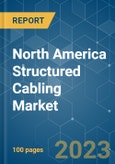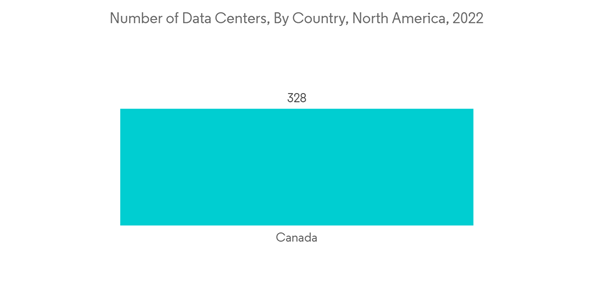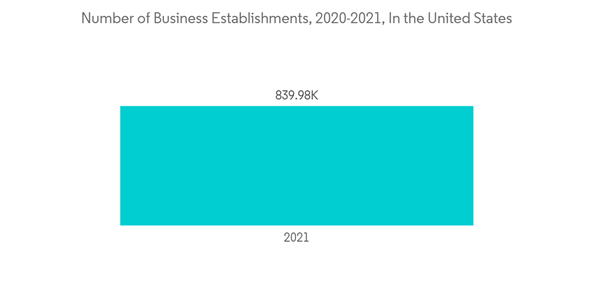Key Highlights
- Structured cabling is defined as building or campus telecommunications cabling infrastructure. Typically, it consists of several standardized, more minor elements. Structured cabling systems are the most adaptable technology that is constantly being updated, as this technology helps make networking user-friendly and organized. Moreover, the fiber and copper ports deployed offer higher scalability for future growth, which is crucial in a data center and is one of the driving factors for the structured cabling market's growth.
- The structured cabling uses a predefined, standards-based design with predefined connection points and pathways. The cabling used in a structured wiring design is specified by the bandwidth requirements of the system and is tested to ensure proper performance. Although a structured cabling system may take longer to install and have a higher initial cost, the operational cost is ultimately lower, and the system's life cycle will be longer when compared to an unstructured system.
- With the rise of intelligent cities, the number of public and private cloud data centers has been increasing rapidly. The significant increase in internet users and the demand for personal cloud storage are the few driving factors for structured cabling in the North American region. Furthermore, the North American region is among the most critical data center markets, supporting the studied market's growth. For instance, according to CloudScene, the United States will have about 2,701 data centers in 2022.
- The increasing demand is attracting new players to enter the North American market. For instance, in March 2022, Vantage Data Center announced its expansion in Canada with a new campus in Montreal and further expansions to existing sites in Montreal and Quebec City. The company said it would invest an additional CAD 900 million (USD 713 million) in scaling its Canadian operations.
- Similarly, Amazon Web Services (AWS) recently announced an expansion of its infrastructure in Canada. The company will establish a data center region in Calgary that will be available to millions of AWS customers in Canada, including many Alberta-based businesses and public sector organizations.
- However, factors such as the high initial investment required challenge the growth of the studied market. Additionally, the increasing proliferation of wireless equipment and devices is also expected to challenge the growth of the studied market during the forecast period.
- The structured cabling market faced significant delays, particularly in the North American region, where the outbreak of COVID-19 led to the government implementing stringent lockdown measures, resulting in a slowdown in new infrastructure development projects. However, the pandemic has significantly enhanced the adoption rate of digital technologies, which is expected to drive investments in new data centers and IT resources, creating growth opportunities for the studied market.
North America Structured Cabling Market Trends
Data Center to Hold Significant Market Share
- A data center is a facility that centralizes an organization's shared IT operations and equipment to store, process, and disseminate data and applications. Because they house an organization's most critical and proprietary assets, data centers are vital to the continuity of daily operations. Data centers support almost all computation, data storage, and network and business applications for the enterprise.
- The ramping up of the digital economy fueled by emerging technologies and ever-increasing data has been placing enormous demands on data center infrastructure. Data centers need more capacity to support remote IT capabilities quickly, more e-commerce, increased video streaming and gaming, and a greater need for applications like telemedicine, distance learning, and online collaboration, encouraging the vendors to invest more in data centers. As of January 2022, according to Cloudscene, there were about 2,701 data centers in the United States.
- The emerging Internet of Things/Industrial Internet of Things (IoT/IIoT) and 5G-enabled technologies like self-driving cars, virtual and augmented reality, artificial intelligence (AI), machine-to-machine (M2M) communication, and advanced data analytics are already fueling data center expansion. For instance, in April 2022, Google announced and investment of USD 9.5 billion on new Google data centers and offices in 2022 with the unveiling of a new USD 750 million data center in Nebraska. These investments are majorly focused on expanding the company's footprint in southern and western regions of the country.
- Similarly, in May 2022, Amazon Web Services (AWS) announced their plan to spend almost USD 12 billion on five new data centers in Morrow County near Oregon, United States. The cloud hosting division of the company said that the investment would more than double the size of its operations in the relatively rural region. According to the company, each new data center costs around USD 2.37 billion, with about USD 280 million being earmarked for the land and buildings. Such investment in the data centers is expected to attract various companies' investments to develop structural cabling in the market.
- A similar trend has been observed in Canada as well, wherein the growing adoption of cloud services and increasing penetration of digital technologies are significantly driving the demand for storage spaces, creating a favorable market scenario for the growth of the studied market.
United States to Witness Significant Growth
- The massive growth of Internet users and smart mobile communication devices is driving strong demand for data center services in the United States. The emergence of 5G and the increasing acceptance of connected devices are also expected to support the growth of the data center industry in the country. For instance, according to the GSMA, the number of IoT connections in North America is expected to grow from 2.3 billion in 2018 to 5.4 billion in 2025. With the US expected to remain a major shareholder, such trends will create opportunities in the market under consideration.
- New government policies in the United States aim to increase data center investment as part of an effort to make the country a data traffic hub.Such trends are driving data center infrastructure investment in the United States, which in turn is driving the demand for structured cabling in the country. For instance, the Data Center Optimization Initiative (DCOI) is designed to improve data center optimization in the Federal Government and look after the data center requirements of the Federal Government.
- The rapid developments in the information technology sector, combined with drivers like mass consumption of products, urbanization, a surge in mobile usage, and a tech-hungry young population, also positively impact economic growth in the United States. For instance, according to the Bureau of Labor Statistics, there were almost 840,000 businesses in the country, with a significant number of businesses in the United States using cloud services. Such trends create a favorable market scenario for the studied market.
- Smart city initiatives are also driving demand for the structured cabling market. For instance, in October 2022, Honeywell announced that it was engaging with five U.S. cities to provide in-kind support to accelerate progress on their smart city strategic planning. The cities are Cleveland, Louisville, Ky., Kansas City, Mo., San Diego, and Waterloo, Iowa. Similarly, in December 2021, Caliber, based in Scottsdale, AZ, and United Cities North America (UCNA), created and built sustainable and net-zero (smart) cities and communities, thus driving the demand for structured cabling.
North America Structured Cabling Market Competitor Analysis
The North America structured cabling market is fragmented due to the presence of several players. The major players have used strategies, such as new product launches, joint ventures, partnerships, collaborations, and acquisitions, to increase their footprints in this market and sustain themselves in the long run. Key players in the market are Belden Inc., Commscope Inc., Corning Incorporated, Legrand S.A., the Siemon Company, Anixter Inc., and many more.In November 2022, Oracle Labs in Broomfield, Colorado, got assistance from CommScope to upgrade its network infrastructure. Oracle Labs selected the SYSTIMAX copper and fiber structured cabling systems offered by CommScope, which helped the company increase its throughput capacity to 1.2 terabytes from about 300 gigabytes.
In October 2022, GTA TeleGuam, a Guam-based telecom company, broke ground on a new data center and cable landing station (CLS). The 4MW, two-story, 31,000 sq ft data center is anticipated to be completed in 2024 and will be able to house up to six submarine cables.
Additional benefits of purchasing the report:
- The market estimate (ME) sheet in Excel format
- 3 months of analyst support
This product will be delivered within 2 business days.
Table of Contents
Companies Mentioned (Partial List)
A selection of companies mentioned in this report includes, but is not limited to:
- Belden Inc.
- The Siemon Company
- Corning Incorporated
- Commscope, Inc.
- Anixter Inc
- Legrand S.A.
- Pangen Solutions
- Siemens AG
- Schneider Electric SE
- Datwyler IT Infra GmbH
Methodology

LOADING...










